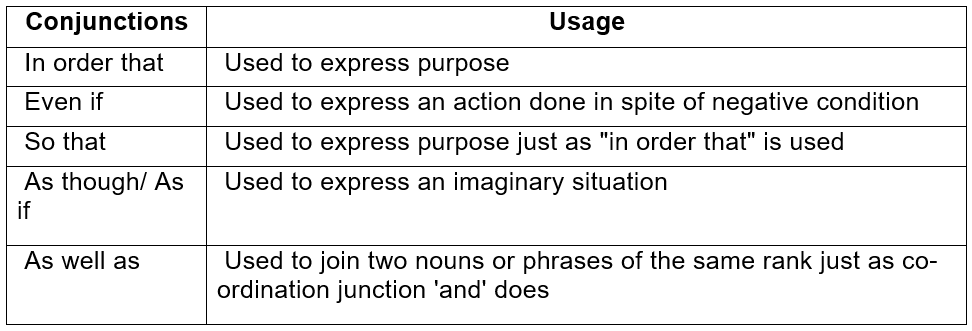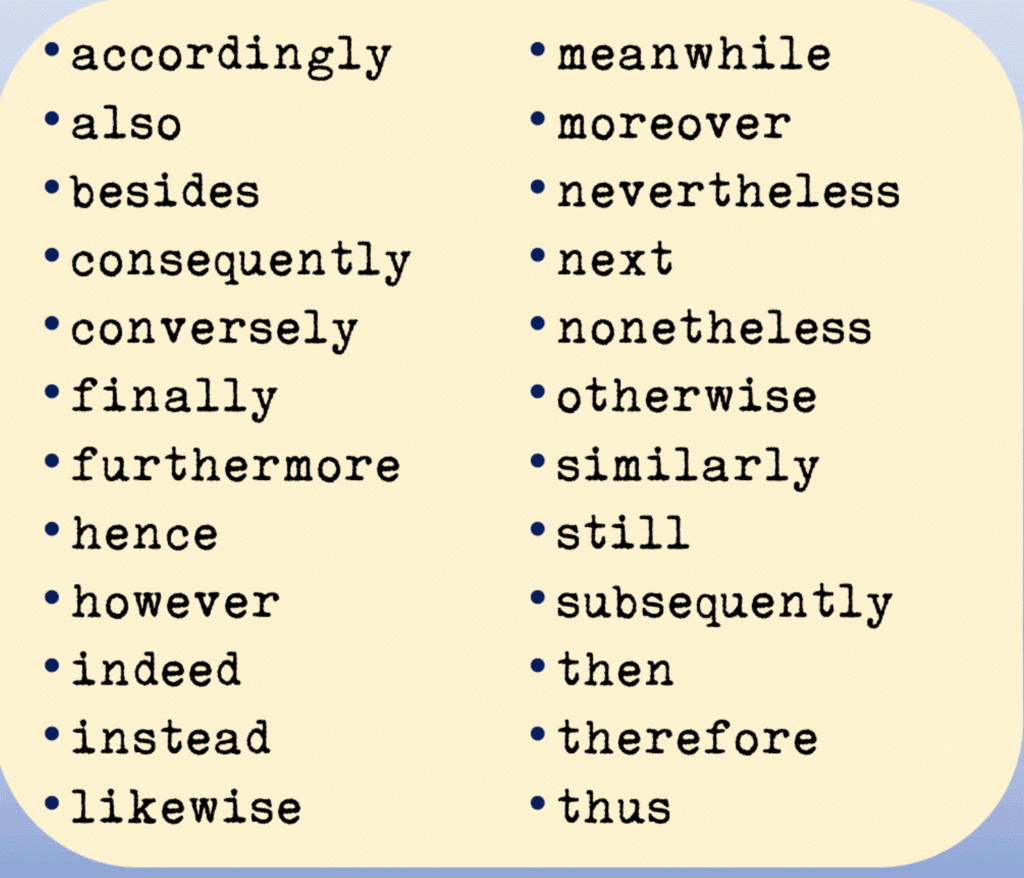Detailed Notes: Conjunctions (Sentence Connectors) | English Grammar Advanced - Class 10 PDF Download
Understanding Conjunctions
A conjunction is a word used to connect two or more words, sentences, or clauses. For instance:
- Pride and honour (Here, ‘and’ connects the words pride and honour).
- She is a singer .
- He is a dentist .
- She is a singer, but he is a dentist. (In this case, ‘but’ connects two sentences).
- The poor had died before the government distributed food. (‘Before’ links two clauses).
Types of Conjunctions
There are five types of conjunctions:
- Coordinating Conjunctions
- Correlative Conjunctions
- Sub-ordinating Conjunctions
- Compound Conjunctions
- Linking adverbs and transition words
1. Coordinating Conjunctions
The coordinating conjunctions are used to connect words, phrases and clauses of equal ranks. The coordinating conjunctions include : (and, but, or, nor, for, yet, so).
- And: It is used to combine two words, sentences or ideas,
Examples:
1. I like to drink tea and coffee.
2. He eats cake, chocolate, pastry and chips. - But: It is used to connect to contrast ideas,
Examples:
1. Andy likes red, but Sophie likes blue.
2. I am dancing, but she is singing. - Or: It is used to express a choice between two things,
Examples:
1. You can eat it with a fork or a spoon.
2. You are making the diagram horizontally or vertically. - Nor: It is used to combine two words or ideas both of which are to be negated,
Examples:
1. Ram is drinking neither hot chocolate nor coffee.
2. Kiran has not come nor has Shyam. - For: It is used as a conjunction of purpose or reason,
Examples:
1. I cannot attend the meeting for I am unwell.
2. I am not willing to spend so much money on it for it is very expensive. - Yet: It is used to express that something has not happened but you expect it to happen.
Examples:
1. I am not very comfortable doing it yet I will try doing it.
2. Rocky terrorises the poodles next door yet adores the German Shepherd across the street. - So: It is used as a conjunction of result or consequence.
Examples:
1. Everyone was busy in work, so I brought all the items myself.
2. All the rooms of the hotel were occupied, so I had to shift here
The poor villagers can neither read ______ write their own language.
2. Correlative Conjunctions
Those conjunctions that are used in pairs to connect two words, phrases or sentences are known as correlative conjunctions.
- Either … Or: It is used to show choice between two things.
Examples:
1. Either Max or James has taken the pen.
2. I will drink either cold coffee or ice tea. - Neither … Nor: It is used to refuse both of the choices.
Examples:
1. I will go to neither Jaipur nor Jaisalmer.
2. Neither they are writing nor are they allowing me to write. - Both … And: It is used to combine two ideas.
Examples:
1. My brother is both smart and intelligent.
2. I will eat both North Indian food and Chinese food. - Whether … Or: It is used to express doubt or choice between two things.
Examples:
1. Tell me whether you will do it or not.
2. Do you know whether it will be raining today or not? - Not Only … But Also: It is used to express the inclusion of more than one things.
Examples:
1. She is not only a dancer but also singer.
2. We are not only composing the music for a film but also directing a film.
______ you tell the truth or face the consequence.
3. Sub-ordinating Conjunctions
A sub-ordinating conjunction joins a clause to another on which it depends for its full meaning.
- After: It is used to express the sequence of happening of two things.
Examples:
1. I will drink the milk after my brother drinks it.
2. You could go and play after you have done the dishes. - If: ‘If’ is used to express a condition in the clause.
Examples:
1. If you work hard you will pass.
2. She may look beautiful if she uses this cream. - Though, Although and Even though: It is used to show a contrast between the two clauses.
Examples:
1. Though he is poor, he is honest.
2. Though she was intelligent, she failed.
3. I was late to my work even though I helped the old lady. - If Only: It is used to show a specific condition stated in the clause.
Examples:
1. If only, I would be a Prime Minister.
2. I could get there, if only, tomorrow. - Till: It is used to show the extent of time in the clause,
Examples:
1. Wait here till I come.
2. He practised for the exams till late. - As: It is used to show time, cause and reason in a sentence,
Examples:
1. As I left my home, I found a purse.
2. She is weak as she was ill. - In order that: It is used to show the purpose in the sentence.
Examples:
1. We eat in order that we may live.
2. She walked faster in order that she could got the bus. - Unless: It shows the negativity stated in a condition,
Examples:
1. You will not pass unless you study.
2. She will not stop crying unless she meets her father. - As if: This is used to show an imaginary condition in a sentence.
Examples:
1. He talks to me as if he were my boss.
2. She behaves as if she were a dictator. - Now that: This is used to show a current situation which is the outcome of some past event.
Examples:
1. Now that it is clear India is in the semifinal, we are celebrating.
2. Now that her marriage has been fixed she wanted to quit her job. - Until: It shows the negativity related to time in a sentence.
Examples:
1. Do not go until I come.
2. They are not ready to pay until they get the house. - As long as: It is used to show the extent of time and its duration related to an event.
Examples:
1. As long as electricity is supplied, the machine will run.
2. She is the new captain as long as the previous captain recovers. - Once: It shows the limited frequency of an event to one.
Examples:
1. Once she was in England,
2. I take tea once in a day. - When: It shows the time related to an event in a sentence.
Examples:
1. I know the time when she was born.
2. She is aware when they could harm her. - As though: It shows the manner of an event in the sentence.
Examples:
1. He showed the anger as though he were the victim of it.
2. She cared the baby as though she were her mother. - Rather than: This is used to show preferences or choices in a sentence.
Examples:
1. She would die rather than beg.
2. I would live in Delhi rather than London. - Whenever: This shows the definite situation in a sentence.
Examples:
1. Whenever I wanted to meet him, he didn’t come.
2. I keep myself in my mother’s cap whenever I feel sad. - Because: It is used to express the reason of an action.
Examples:
1. I will eat a pizza because I am hungry.
2. We have to clean the house because tomorrow is Diwali. - Since: This is used to show a time reference in a sentence.
Examples:
1. I have been doing this since January.
2. She may pass since she had studied this subject. - Where: It shows place or position specification in a sentence.
Examples:
1. I do not know where it is to be kept.
2. She may go where she wanted to. - Before: It is used to show a position, a time that states an event finished earlier.
Examples:
1. Get ready to go before the jury.
2. She had written a letter before me. - So that: It is used to show a result or an outcome of any event.
Examples:
1. She is reading so that she can pass.
2. India is planning to enter manufacturing so that revenue can be generated. - Whereas: It shows the contrast between the two clauses.
Examples:
1. She is intelligent whereas her brother is not.
2. America is developed whereas India is developing. - Even if: It is used to put a stress on the given conditionals.
Examples:
1. I shall not give it you even if I am told officially.
2. She will continue her education even if she gets married. - Than: It is used for the purpose of comparison,
Examples:
1. It is better to leave than doing it.
2. It was easier said than done. - Wherever: It is used to put positional stress in a sentence.
Examples:
1. I shall go with you wherever you go.
2. Police shall take him out no matter wherever he has hidden himself. - That: It is used to join the two different clauses in the sentence.
Examples:
1. She told me that she was a poet.
2. They know that you can be handy. - While: It is used to combine the two dynamic verbs that may be simultaneous or may not be.
Examples:
1. I was reading while eating.
2. She was talking while crossing. - On condition that: It is used to express a condition which is a necessity for another action.
Examples:
1. I can give you this book on condition that you will keep it safe.
2. She returned the phone on condition that he would never irritate her. - Provided: It is used to express a conditional statement which is either a warning or a requirement for the other action.
Examples:
1. You may go on leave provided the project is finished on time.
2. She will marry you provided she is allowed to study further.
4. Compound Conjunctions
Compound conjunctions are the groups of words (phrases) that are used as conjunction.

5. Linking Adverbs and Transition Words
These are used to connect two independent clauses or sentences. The linking adverbs and transition words are used to provide transition between ideas. Linking adverbs and transition words include.

|
53 videos|210 docs|40 tests
|
FAQs on Detailed Notes: Conjunctions (Sentence Connectors) - English Grammar Advanced - Class 10
| 1. What are conjunctions and why are they important in English grammar? |  |
| 2. What are the different types of conjunctions? |  |
| 3. How can I effectively use conjunctions in my writing? |  |
| 4. What are some common mistakes to avoid when using conjunctions? |  |
| 5. How can I practice using conjunctions correctly? |  |

















